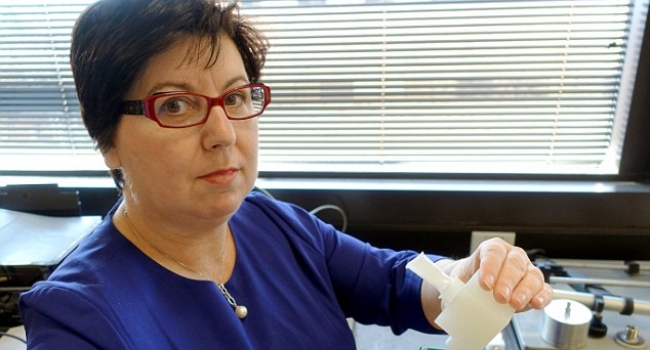- Latest news▼
-
12:27, April 23 Appetite: Scientists found out the secret to the appeal of large portions of fast food

-
10:33, April 23 Scientists test new approach to fighting viruses

-
08:38, April 23 Ketamine may help with postpartum depression

-
22:12, April 22 Unhealthy amount of sugar found in baby food products of a well-known brand

-
19:41, April 22 Air pollution puts health of more than 1.6 billion workers globally at risk

-
17:25, April 22 Scientists found baked goods and lack of sleep to be more dangerous than alcohol

-
16:02, April 22 342 cases of measles recorded in Armenia so far in 2024

-
15:29, April 22 BrainStimulation: electrical brain stimulation alleviates anxiety and depression in the elderly

-
08:27, April 22 Cognitively stimulating jobs in midlife could lower dementia risk in old age, study finds

-
20:37, April 21 Environmental Health Perspectives: Microplastics ingested with food and water can spread from the gut to the brain

-
22:41, April 20 Scientists develop new method to safely stimulate immune cells to fight cancer

-
20:46, April 20 Blood test can determine who is at risk of developing multiple sclerosis - scientists

-
18:36, April 20 Next pandemic likely to be triggered by flu - scientists

-
12:16, April 19 Scientists grow human mini-lungs in lab

-
10:23, April 19 JAMA Oncology: Urine test can help rule out high-grade prostate cancer with almost 100% accuracy, study shows

All materials
Breathalyser uses sensors to detect the flu virus

Scientists have developed a breathalyser that can detect the flu virus.
The patient - or malingering partner - simply breathes into the hand-held monitor which uses semiconductor sensors like those in a household carbon monoxide detector.
But in the new device, the sensors identify biomarkers linked to the virus and indicate if the sufferer has flu or just wants a 'duvet day'.
The breathalyser, similar to the machines used by cops for roadside alcohol tests, was developed by Professor Perena Gouma, from the Materials Science and Engineering Department at The University of Texas, Arlington.
Eventually it is hoped the machine will be available in high street chemists so people can be diagnosed earlier and take advantage of medicine used to treat the flu in its earliest stages.
It could also help prevent flu epidemics from spreading, protecting both individuals as well as the public health.
But it could also be adapted to diagnose other diseases, including ebola, according to the study published in the journal Sensors.
Prof Gouma and her team used existing research to work out the quantities of known biomarkers present in a person's breath when afflicted with a particular disease, then applied that knowledge to find a combination of sensors for those biomarkers that is accurate for detecting the flu.
For example, people who suffer from asthma have increased nitric oxide concentration in their breath, and acetone is a known biomarker for diabetes and metabolic processes.
When combined with a nitric oxide and an ammonia sensor, Gouma found that the breath monitor may detect the flu virus, possibly as well as tests done in a doctor's office.
Prof Gouma, who is also the lead scientist in the University's Institute for Predictive Performance Measurement said: 'I think that technology like this is going to revolutionise personalised diagnostics.
'This will allow people to be proactive and catch illnesses early, and the technology can easily be used to detect other diseases, such as Ebola virus disease, simply by changing the sensors.
'Before we applied nanotechnology to create this device, the only way to detect biomarkers in a person's breath was through very expensive, highly-technical equipment in a lab, operated by skilled personnel.
'Now, this technology could be used by ordinary people to quickly and accurately diagnose illness.'
Prof Stathis Meletis, chair of the Materials Science and Engineering Department, said: 'Dr. Gouma's development of a portable, single-exhale device that can be used to detect diseases has implications far beyond the laboratory.
'This shows the impact of nanotechnology on our everyday lives, and has potential for applications related to security and other important areas as well.'
Follow NEWS.am Medicine on Facebook and Twitter
- Video
- Event calendar
- Archive
- Most read
month
week
day
- JAMA Oncology: Urine test can help rule out high-grade prostate cancer with almost 100% accuracy, study shows 1175
- Daily Mail: Elderly woman in China gets infected with brain-eating amoeba 1149
- Obesity: exercising before breakfast helps you lose weight faster 1134
- The Conversation: childhood trauma can cause pathological hoarding 1133
- Daily Mail: Satiating food reduces cravings for sweets, nutritionist says 1106
- First Armenian-German Conference entitled “Heart Failure Spring School” 1054
- Scientists grow human mini-lungs in lab 1011
- Why do kids usually recover from COVID-19 more easily than adults? 1004
- Next pandemic likely to be triggered by flu - scientists 569
- Scientists found baked goods and lack of sleep to be more dangerous than alcohol 505
- Blood test can determine who is at risk of developing multiple sclerosis - scientists 463
- Scientists develop new method to safely stimulate immune cells to fight cancer 457
- 342 cases of measles recorded in Armenia so far in 2024 449
- Cognitively stimulating jobs in midlife could lower dementia risk in old age, study finds 437
- BrainStimulation: electrical brain stimulation alleviates anxiety and depression in the elderly 386
- Find us on Facebook
- Poll





